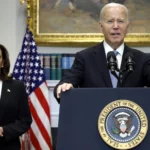Over time, the India-USA defence partnership has grown and changed, as both nations have come to understand the importance of strengthening their strategic alliance in the face of domestic and international security threats. The Initiative on Critical and Emerging Information Technology (iCET), which intends to foster cooperation in cutting-edge technologies like artificial intelligence, quantum computing, and cybersecurity, is anticipated to be launched by the two nations in 2023. While this programme has the potential to improve India and the US’s security cooperation, it also brings up a number of pressing problems that must be resolved.
The iCET is a component of India’s and the US’s larger initiatives to deepen their cooperation in emerging technologies, which are crucial to both nations’ economic and security interests. As part of its Digital India and Make in India efforts, which seek to encourage innovation, entrepreneurship, and self-reliance, India has been heavily investing in these technologies. The US, on the other hand, has been a pioneer in these technologies and has been working to deepen its alliances with significant allies and partners in order to maintain its competitive edge and boost its security. In order to improve collaboration in sectors like defence, homeland security, and disaster response, the iCET aspires to take advantage of both nations’ strengths and capacities in key and developing information technology. The effort will concentrate on fields including artificial intelligence, quantum computing, cybersecurity, and 5G networks and will involve joint research and development, technology transfer, and capacity building. It is anticipated that the iCET will foster innovation and entrepreneurship in these fields and open up new channels for cooperation between the tech industries of India and the US.
India’s strategic thought and iCET
As the recent survey conducted by the United States-based global business intelligence company, Morning Consult shows Indians conceive China as the number one military and strategic threat towards India, due to The continuous border dispute between India and China is making India’s top geopolitical worries in South Asia. The most recent border clash between India and China took place in June 2020 at Galwan Valley and was extremely severe. In order to strengthen India’s military capabilities and better secure its borders and national interests, the iCET programme can be extremely important. For instance, India and the US can work together on cutting-edge cybersecurity technologies to stop cyberattacks from China. Chinese cyberattacks are well-known and have attacked Indian military and government institutions. India can improve the security of its critical infrastructure and sensitive data by creating cutting-edge cybersecurity solutions through the iCET programme.
In a broader sense, India can work with the US to advance its military prowess using artificial intelligence (AI) technologies. AI is being employed more frequently in military operations and has the potential to significantly improve situational awareness and decision-making. India can improve its defence capabilities, lower the danger of deaths, and gain a tactical advantage over its rivals by utilising AI technologies through the iCET programme. India might use the iCET programme to address its worries about Pakistan, which is frequently considered a centre for terrorist activity. Several terrorist incidents in India, like the Pulwama attack in 2019 and the 2008 Mumbai attacks, have implicated Pakistan. India can more effectively identify and stop terrorist activities by collaborating with the US on cybersecurity and information gathering reducing the threats emanating from Pakistan.
India’s reliance on foreign vendors for its defence needs can be lessened attributable to the iCET project. India has historically relied on imports of defence equipment from nations like Russia and Israel. However, each of these nations has unique geopolitical objectives, which may put India at risk. India can lessen its reliance on imports and therefore its vulnerability to geopolitical pressures by working with the US on developing technology. Additionally, India may support regional stability and collaboration in South Asia by utilising the iCET programme. India can improve relations with other nations in the region by creating and disseminating cutting-edge technologies to its neighbours, lowering the danger of conflict and fostering economic development.
First off, the iCET programme can offer India cutting-edge technologies that would enable it to strengthen border security and address other security-related issues. Due to China’s heightened military presence in the area and the long-standing border conflict between India and China, India’s national security has come under scrutiny. India can improve its technological prowess by working with the US on cutting-edge technologies like cybersecurity, artificial intelligence, and quantum computing. This will enable it to better control its borders and safeguard its national interests. Second, the iCET programme can assist India in lessening its reliance on China for vital technologies. Due to its reliance on China for a large portion of its technology requirements, India is more susceptible to Chinese geopolitical pressures. India can lessen its reliance on China and other foreign suppliers while also decreasing its vulnerability to geopolitical pressures by working with the US on future technology. Third, the iCET effort can aid India in fostering collaboration and stability within the Indo-Pacific region. India has been working to encourage a rules-based order in the region as a result of China’s aggressive growth in the area, which has caused concerns about regional stability.
India may be more proactive in regional diplomacy, which will help the area become more stable and prosperous. Fourth, India can confront China’s aggressive infrastructure building in the area, especially in Pakistan, with the aid of the iCET programme. China has made significant investments in Pakistani infrastructure projects, which India sees as a security threat. India can more effectively identify and stop terrorist operations, lowering the dangers coming from Pakistan, by collaborating with the US on cybersecurity and information gathering. Fifth, the iCET programme can aid India in fending off China’s expanding sway in the area, notably in the digital sphere. Concerns about China’s expanding influence in the world have been expressed as a result of its enormous investments in cutting-edge technologies like artificial intelligence and quantum computing.
Limitations:
India can counter China’s influence by playing a bigger part in determining the future of the digital sphere in the region by working with the US on developing technologies. However, the iCET also brings up a number of important problems and difficulties that must be resolved. First, the effort must make sure that there is no asymmetry in the connection and that the advantages of a partnership are distributed equally between the two nations. India has made great progress in the fields covered by the iCET and has the ability to significantly contribute to the relationship, even though the US is a global leader in several of these fields. Second, the transfer of important and cutting-edge information technology may be fraught with hazards and difficulties. Collaboration in these sectors has the potential to be very beneficial, but it can also lead to new security dangers, such as the possibility of technology leaks, espionage, and cyberattacks. The iCET must develop strong procedures for technology transfer and protection, including unambiguous rules regarding the extent and conditions of technology transfer as well as the creation of secure channels for communication and collaboration. In order to protect both nations’ interests during the technology transfer process, the iCET must also address the problem of intellectual property rights.
Thirdly, the iCET must make sure that the collaboration in emerging technologies is in line with India’s and the US’s larger strategic goals. Cooperation in technology can be very beneficial, but if it is not in line with the two countries’ larger strategic goals and values, it could also lead to new conflicts and friction. The relationship must be led by the values of openness, mutual benefit, and respect for sovereignty and territorial integrity, and the iCET must make sure that it is not used to advance particular agendas or narrow interests.
Fourthly, The price of technology creation and transfer represents yet another possible obstacle. Both financial and human resources must be heavily invested in the development of cutting-edge technologies like artificial intelligence and quantum computing. To stay up with the constantly changing technology scene, India will need to invest significantly in research and development. Government, business, and academics will need to work closely together to accomplish this.
In conclusion, India has a significant opportunity to address its geopolitical issues in South Asia thanks to the iCET programme. India can improve its scientific prowess, lessen its reliance on imports, and foster regional stability and cooperation by working with the US on developing technology. However, India will have to deal with potential risks and difficulties related to the project, such as technology leaking, the price of development, and the requirement for close US cooperation. If properly run, the iCET effort can assist India in establishing itself as a regional technology leader and enable it to take a more active part in maintaining peace and security in the region.















